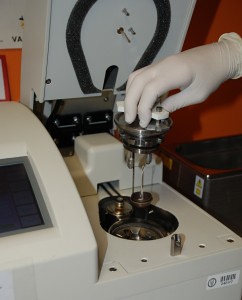Determinación del poder calorífico superior (UNE-EN 14918)
La determinación del poder calorífico de un combustible es fundamental, ya que indica el contenido energético del combustible por unidad de masa. El poder calorífico del combustible indica la densidad energética del mismo.
Normativa aplicable
-
UNE-EN 14918 Biocombustibles sólidos. Determinación del poder calorífico.

Calorímetro
-

Microbalanza
Calorímetro isoperibólico Parr 6300. Produce la combustión de la muestra en oxígeno de pureza 99,5%.
-
Balanza con una precisión de al menos 0,1 mg.
-
La masa de la muestra ha de ser inferior a 1 g.
-
Se determina el contenido en humedad de la muestra.
-
Se tara el pocillo que albergará el material de calibración (ácido benzoico). Se sitúa el material de calibración en el pocillo y se determina su masa.

Preparación del patrón de calibración

Preparación de la muestra
-
Se sitúa el pocillo con el material de calibración en la bomba calorimétrica colocando la mecha de algodón entre el cable de ignición y el pocillo con el material de calibración.
-
Se realiza un test en el calorímetro con el material de calibración.
-
El pocillo que contendrá la muestra se tara. Se sitúa la muestra en el pocillo y se determina su masa.
-
Se sitúa el pocillo con el material de calibración en la bomba calorimétrica colocando la mecha de algodón entre el cable de ignición y el pocillo con el material de calibración.
-
Se realiza un test en el calorímetro con la muestra.
Resultados del ensayo
-
Poder calorífico superior de la muestra en base húmeda.
- Poder calorífico superior de la muestra en base seca.

Introducción de la bomba en el calorímetro
The determination of the heating value of a fuel is essential since it is an indication of the energetic content of the fuel per unid of mass. The heating value of a fuel determines its energetic density.
European Standard
-
EN 14918 Solid biofuels – Determination of calorific value.

Calorimeter
-

Microscale
Isoperibolic calorimeter Parr 6300. The combustion of the sample is produced in an atmosphere of oxygen with a purity of 99.5%.
-
Scale with an accuracy of 0.1 mg.
-
The mass of the sample must be lower than 1 g.
-
The moisture content of the sample is determined.
-
The pan containing the calibration standard (benzoic acid) is tared and the calibration standard is place in the pan to determine its mass.

Preparation of the calibration standard

Preparation of the sample
-
The pan containing the calibration standard is placed in the calorimeter and the cotton fuse is arranged between the ignition wire and the pan with the calibration standard.
-
A test is carried out in the calorimeter with the calibration standard.
-
The pan for the sample is tared and the sample is placed into it to determine the mass of the sample.
-
The pan containing the sample is placed in the calorimeter and the cotton fuse is arranged between the ignition wire and the pan with the sample.
-
A test is carried out in the calorimeter with the sample.
Experimental results
-
High heating value of the sample on a wet basis.
- High heating value of the sample on a dry basis.

Introduction of the bomb in the calorimeter